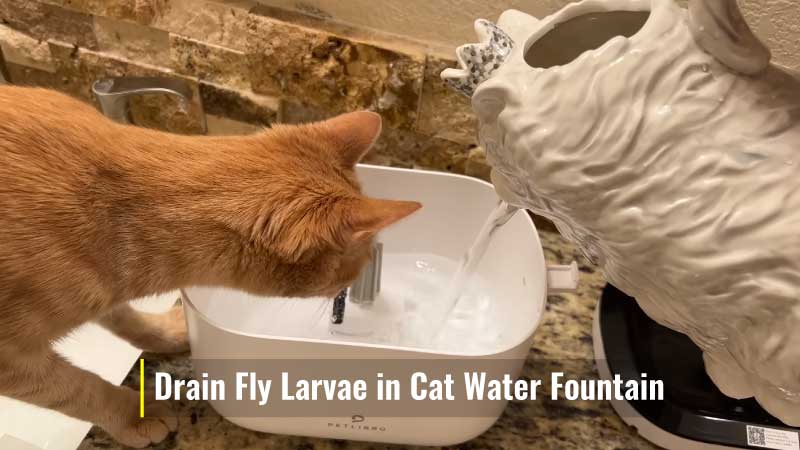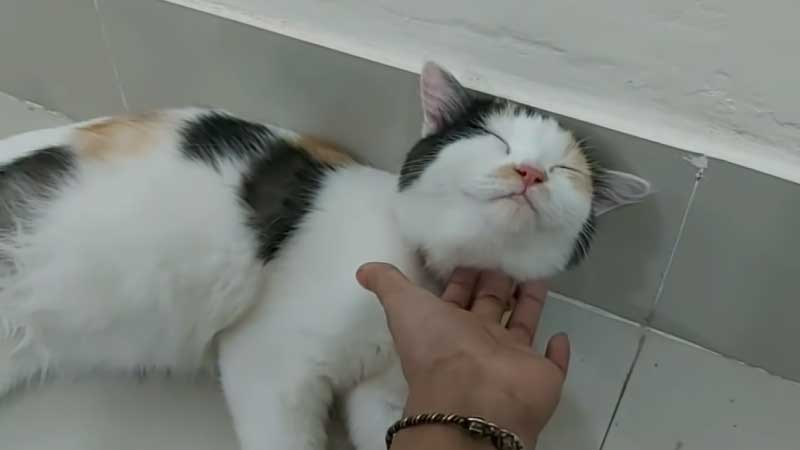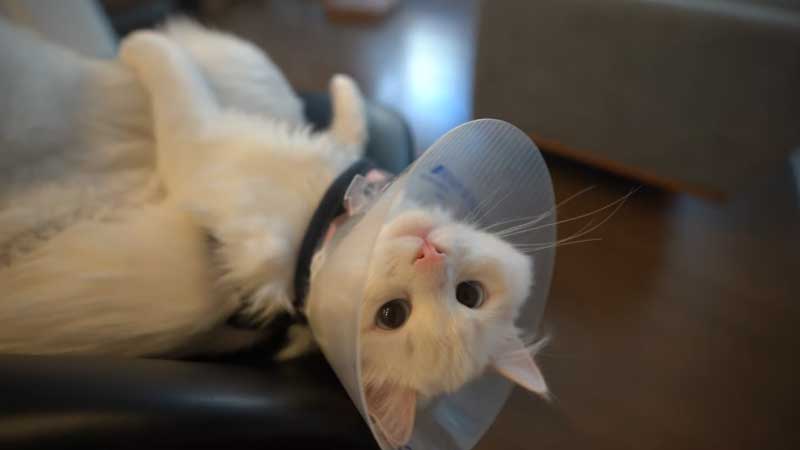Have you ever noticed tiny, awkward creatures in your cat’s water bowl and wondered? Many cat parents have been shocked to find drain fly larvae making themselves at home in their feline’s drinking spot.
“What are drain fly larvae in cat water fountain?”
Drain fly larvae are tiny, worm-like creatures that thrive in stagnant water and organic debris. When they find their way into cat water fountains, it’s usually because of a combination of stagnant water and leftover food particles. While they aren’t directly harmful to cats, they indicate a need for better fountain maintenance and can be an ugly nuisance.
Keep reading to learn more about these little pests and how to ensure your cat’s water stays fresh and free from unwanted guests!
Table of Contents
Signs of Drain Fly Larvae in Cat Water Fountain

Drain fly larvae, while small, can be easy to spot if you know what to look for. Let’s delve into the signs that hint at their presence:
Visual Indicators
Drain fly larvae are small, worm-like creatures. They’re translucent to pale white and can sometimes have a slight dark stripe down the middle. Unlike the water’s natural ripples, you might notice subtle wriggling or squirming movements at the base of the fountain or on the edges. These are tiny, jelly-like masses that might be clinging to the sides of the fountain or submerged in the water. They can sometimes be mistaken for mold or algae.
Behavioral Changes in Cats
If your cat hesitates before sipping or suddenly seems uninterested in drinking from the fountain, it might be sensing something’s wrong. Some cats might try to “fish out” the larvae or the egg clusters out of sheer curiosity or discomfort. While not always a direct indication, unusual meowing or vocalizations near the fountain can be a sign of discomfort or dissatisfaction.
Comparison between Drain Fly Larvae and Other Common Pests Found in Water Sources
| Feature | Drain Fly Larvae | Mosquito Larvae | Algae |
|---|---|---|---|
| Size | Tiny (2-5 mm) | 5-10 mm | Varies |
| Color | Translucent to pale white | Dark head, clear body | Green or blue-green |
| Movement | Wriggling/squirming | Jerky swimming | None |
| Location in Fountain | Base or edges | Floating near surface | Everywhere |
| Reaction to Disturbance | Slow movement | Darting away | None |
Being aware of these signs, you can act swiftly to ensure your cat’s water fountain remains a clean and inviting spot for your feline companion to drink from.
Why Cat Water Fountains Are Prone to Drain Fly Infestations?

Your cat’s water fountain, meant to provide a continuous source of fresh water, might unexpectedly become a hotspot for drain fly larvae. But how does this happen? And why are these fountains particularly susceptible? Let’s explore the reasons.
1. Stagnant Water and Organic Debris as Attractions:
Drain flies are naturally drawn to moist environments, especially places where water stands still for extended periods. While many cat water fountains have continuous circulation, some corners or crevices can still hold stagnant water. Additionally, organic debris such as food particles, saliva, or even traces of cat food can inadvertently drop into the fountain. This combination of stagnant water and organic material provides an ideal breeding ground for drain fly larvae.
2. Common Mistakes by Cat Owners:
- Irregular Cleaning: Not adhering to a routine cleaning schedule allows debris to accumulate, making the fountain more appealing to drain flies.
- Ignoring Filter Changes: Over time, filters become less effective at trapping debris and need replacement. Using an old, saturated filter can contribute to water contamination.
- Improper Location: Placing the cat water bowl close to open windows or doors can invite drain flies from outside. Also, positioning it near food bowls can lead to food particles getting into the water.
Factors Contributing to Pests in Water Fountains
| Factor | Description | Prevention Tip |
|---|---|---|
| Stagnant Water | Small pockets of still water in the fountain. | Ensure proper circulation and regular cleaning. |
| Organic Debris | Food particles, saliva, or other organic matter in the water. | Clean regularly and place away from food bowls. |
| Irregular Maintenance | Not cleaning the fountain or changing filters routinely. | Stick to a cleaning schedule and timely filter changes. |
| Open Access Points | Fountains placed near open windows or doors. | Position the fountain in a less exposed location. |
| Overfilled Fountains | Water that doesn’t circulate well because the fountain is too full. | Fill to the recommended level. |
Knowing about these factors is the first step in preventing drain fly larvae in your cat’s water fountain. A few adjustments and a bit of diligence can make a world of difference!
Effects of Drain Fly Larvae on Cats

Your cat’s water fountain should be a source of refreshment, a place where your cat can satisfy its thirst with clean water. But the presence of drain fly larvae can raise concerns for many cat owners. So, what exactly happens when these tiny invaders enter your cat’s water source? Let’s break down the effects.
Health Implications
The good news first: drain fly larvae, on their own, aren’t known to be toxic or harmful when ingested by cats. Most cats, if they happen to consume them, will digest them without any issues.
While the larvae themselves aren’t harmful, the environment that encourages their growth might be. Stagnant water and accumulated debris can foster bacteria and other microbes, which may cause gastrointestinal upsets if ingested.
In rare instances, some cats might develop an allergic reaction to the proteins present in the larvae. Symptoms could include itching, hives, or minor skin irritations.
Behavioral Effects
Cats have a keen sense of their environment. If they notice something off about their water, like the presence of wriggling larvae, they might become hesitant or completely avoid drinking from the fountain.
Some cats might find the squirming larvae intriguing and spend more time pawing at the fountain or trying to “fish” them out.
If a cat is consistently avoiding the fountain due to the larvae’s presence, it might drink less water overall, which can affect its hydration levels and overall health.
Ensuring regular cleaning and maintenance can keep these pests at bay and make sure your cat stays both curious and hydrated in a healthy way!
Drain Fly Larvae in Cat Water Fountain: Prevention and Treatment

The sight of drain fly larvae squirming about in your cat’s water fountain can certainly be disturbing. However, with a proactive approach towards prevention and the right treatment methods, you can ensure your feline friend always has access to clean, fresh water. Here’s how:
Step 1: Routine Cleaning and Maintenance of Cat Water Fountains:
- Weekly Cleaning: Dismantle the fountain once a week and clean each component with mild, cat-safe soap. Rinse thoroughly to ensure no soap residues remain.
- Monthly Deep Cleaning: At least once a month, soak the fountain components in a solution of equal parts water and white vinegar to disinfect and remove any mineral build-up. Make sure to rinse well.
- Regular Filter Changes: Ensure you replace the fountain’s filters as per the manufacturer’s recommendations. This can vary from monthly to every few months based on the fountain model.
Step 2: Safe Treatments to Eliminate Larvae:
- Physical Removal: If you notice larvae, immediately remove the water and clean the fountain. A quick rinse will not suffice; a thorough cleaning is essential.
- Boiling Water: After cleaning, rinse the fountain with boiling water. This will kill any remaining larvae or eggs without introducing chemicals.
- Natural Repellents: Certain essential oils, like lavender or eucalyptus, can deter drain flies. However, always ensure any oil you use is safe for cats before considering this option.
Step-by-step Prevention and Treatment Process
| Step | Action | Frequency | Notes |
|---|---|---|---|
| 1 | Dismantle and clean fountain components | Weekly | Use cat-safe soap and rinse thoroughly |
| 2 | Deep cleaning with vinegar solution | Monthly | Equal parts white vinegar and water |
| 3 | Filter replacement | As recommended | Typically every 1-3 months |
| 4 | Inspect for larvae or eggs | Daily to Weekly | Regular checks can help spot issues early |
| 5 | Use boiling water for rinsing | As needed | Only when larvae are spotted |
| 6 | Consider natural repellents | As needed | Only use cat-safe options |
Preparing yourself with knowledge and maintaining a careful approach can prevent drain fly larvae from setting up shop in your cat’s water fountain.
FAQs (Frequently Asked Questions)
How does drain fly larvae get into cat water fountains in the first place?
Drain flies are attracted to moist environments where they can lay their eggs. The life cycle of a drain fly begins when the female lays her eggs in stagnant or slow-moving water. Within 48 hours, these eggs hatch into larvae, which then feed on the organic matter present, such as algae, bacteria, and fungi. Cat water fountains, especially if not maintained properly, can offer the ideal conditions of stagnant water and organic debris, making them an attractive breeding ground for these flies.
Are drain fly larvae harmful to cats?
Directly, drain fly larvae are not toxic or harmful when ingested by cats. However, the conditions that promote their growth in the fountain, such as stagnant water and accumulated organic matter, can foster bacteria and other harmful microbes. These can potentially cause gastrointestinal issues if ingested. Also, in rare cases, cats might develop allergic reactions to proteins in the larvae, leading to minor skin irritations or hives.
How can I prevent a future infestation of drain fly larvae in my cat’s water fountain?
Prevention is rooted in proper maintenance. Regularly clean the fountain, ensuring no pockets of stagnant water remain. Replace filters as recommended by the manufacturer, and avoid placing the fountain near open windows or food sources which can introduce organic debris. If you’re in an area heavily populated by drain flies, consider using mesh screens on windows.
How often should I clean my cat’s water fountain to avoid drain fly infestations?
It’s advisable to clean the cat water fountain at least once a week to prevent any build-up of organic matter or stagnant water. A deeper cleaning, using a solution of equal parts water and white vinegar, should be performed monthly. Additionally, always ensure you replace the fountain’s filters based on the manufacturer’s recommendations, which can vary from every month to every few months.
Can I use insecticides to remove drain fly larvae in cat water bowl?
It’s crucial to avoid using insecticides or any other harmful chemicals in or around your cat’s water fountain. These can pose severe health risks to your feline friend if ingested. Instead, opt for safe, natural treatments like boiling water rinses or cat-safe essential oils, always ensuring that any remedy used is safe for feline consumption.
Final Verdict
Though these larvae are not directly harmful to cats, their presence is a sign of conditions that could lead to other health risks, such as bacterial growth.
Regular maintenance, vigilance, and safe, cat-friendly treatments are paramount to prevent drain fly larvae in cat water fountain. Relying on harmful chemicals is not the solution; instead, frequent cleaning, using natural repellents, and understanding the factors that attract these pests will ensure your cat’s water source remains clean and safe.




